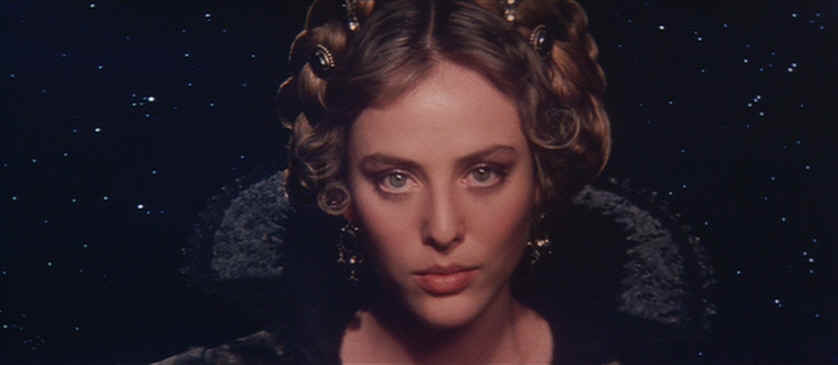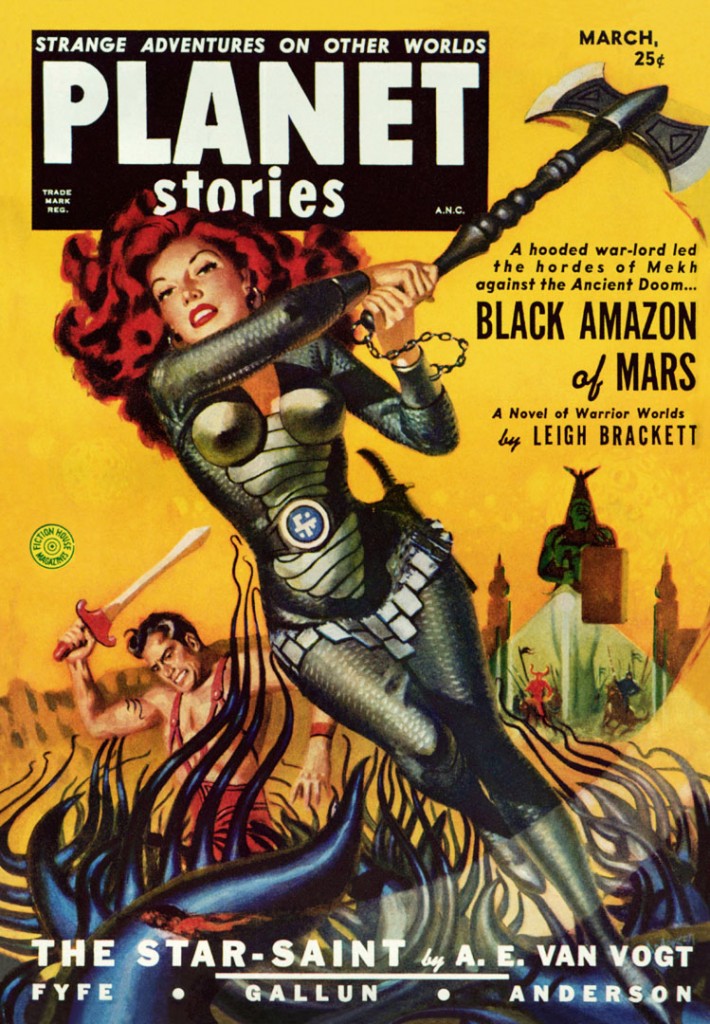And you thought you already knew that? That was only Anecdotal Evidence© and had not been vetted in a really-truly Scientificalistic Experiment™ and statistically analyzed by people who took a whole semester of cookbook Stats for Psychs course back in undergrad! Woo, as they say, hoo!
The description of the methodology employed can be seen at the link on Dr. Briggs' site, and is not to be missed for connoisseurs of the delightfully wacky. The sample size was 76 male college students. That's how we'll draw conclusions about the human race! No indication if these 76 were drawn at random from the population of all male humans on the planet, or indeed of all male college students in the USA, or even of all male college students on the campus in question. Might we suspect it consisted of male college students taking psych courses?
 |
| Open body posture, lying back, tight-fitting, er, clothes... Is this an amenable pose for scoring or is she carrying an invisible serving platter containing an invisible roasted boar? |
Someone once claimed that conclusions in the Social Sciences [sic] were of two kinds:
[The researchers] asked a large group of students (103 men and 91 women) to nominate some “specific actions, cues, body postures, attitudes, and personality characteristics” that might indicate receptivity or vulnerability [in women].This pool of WEIRD people came “up with a list of 88 signs that…a woman might be an especially good target for a man who wanted to score.”
The researchers then searched—wait for it—the internet for images of women who might be amenable to be scored upon. “Once they had pictures of women licking their lips, partying, circling their areolas, and all the rest, they cross-checked them with a separate group of students who surmised” that, yes indeedy, these are women who wanted it. Other items: tight clothing, open body posture, and lying back.
The researchers also found a list images that tended to be mood dousers. Such things as: skinny, old, passed out, sad, distressed, and crying.
This is science, folks.
- Obvious
- Wrong
“pictures of dimwitted- or immature-seeming women, for example, or of women who looked sleepy or intoxicated, did seem to have an effect: Not surprisingly, men rated them as being easy to bed.” And here’s the big “finding”, these easy scores “were also perceived as being more physically attractive than female peers who seemed more lucid or quick-witted.”It is unclear how quick-wittedness can be seen in a photograph. But the news that college boys are attracted to women who seem willing is not exactly up there with Watson/Crick's double helix as a Breakthrough Moment. No word on whether [to simulate the real world] the guys were drunk when they made these assessments.
 |
| Pioneer aviatrix Harriet Quimby: Hot or Not? |
soon to be published in Evolution and Human Behavior, University of Texas–Austin graduate student Cari Goetz and her colleagues explored what they called the sexual exploitability hypothesis.So, rest easy all ye doubters. The whole scientificalistic study was based on Evolution™ and, as we all know, all conclusions in evolutionistical studies are always True by Blatant Assertion™. For a moment there I was worried. At least now we know how grad students spend their time: cooking up Way Kool ways to get credit by persuading college boys to look at sexy pictures. A rotten job, but someone has to do it.
 |
| Princess Irulan of Dune: Does she look quick-witted? Is she easy? |
To determine which cues were diagnostic of exploitability, Pearson correlation coefficients were calculated between the rating means for each cue and the mean of participant responses for each exploitability measure for each picture"Were diagnostic of..." is as good an argument as you can make for the need for better humanities courses on campus.
 |
| Easy to coerce? I'm going with a "no" |
Of the 126 correlations presented in Table 2, 27 correlations were significant beyond the .001 level, where <1 would be expected by chance alone; 38 were significant beyond the .01 level, where 2 would be expected by chance alone; and 45 were significant beyond the .05 level, where 7 would be expected by chance alone.
 |
| A 3-way multinomial distribution |
But wait! The correlation was between "the rating means for each cue" and "the mean of participant responses"? Could that whirring sound be old man Pearson spinning in his grave?
What are these "ratings"?
 |
| Deja Thoris: the dress says "easy" The knife says "wait a minute..." |
The boys were asked to rate each pic through a series of high precision questions like “How attractive is this woman overall?” presumably answered by their desire to be "all over" this woman. These questions were answered on a scale of 1 (not at all) to 5 (extremely).
Now you may notice a problem. Whereas a resistance of 4 ohms is twice as great as a resistance of 2 ohms, an "overall attractiveness" rating of 4 is not twice as attractive as a rating of 2. The attractiveness scale is not a ratio scale. Furthermore, while the difference between 5 ohms and 1 ohm is 4 ohms, the difference between an attractiveness rating of 5 and one of 1 is not "four attractiveness units." The attractiveness scale is not an interval scale.
It is an ordinal scale; and addition and subtraction are not legitimate operations to perform on ordinal scales. The 1-2-3-4-5 may as well be A-B-C-D-E. While it is true that an attractiveness of 4 is "more" than an attractiveness of 2, it is not quantitatively more just because you have used numbers instead of letters. And how do you get a mean value without first adding up a bunch of numbers?
It's no excuse to say that "everyone does it." If everyone jumped off a cliff, would you do it, too?
Then they did correlations between those means. This usually requires that the X's be continuous. If I needed to relate two categorical variables I might incline to some sort of χ² approach, or even a simple tabulation showing the frequency of each response to each image.
It's easy to come up with a ratio scale for "easy" women. Just use ohms. The higher the resistance, the less easy she will be. Attractiveness is more problematical. At first, gravity might seem appropriate; but then the proverbial fat lady in the opera would rate the highest. Magnetism would seem a viable alternative; but magnetism is associated with electricity, and women with a shocking appearance might not be considered attractive.
 |
| Barbie of Troy |
However, since taking a bath is equivalent to launching a small amount of tonnage and cooking meals is a form of burning, even the plainest Jane, said Gaines, may hope through preparing enough dinners and by regular bathing to achieve a cumulative sort of beauty. (See link.)
In this manner, we may hope for improvement in the study cited, since it recommends, as always, that further study is needed. But when they write -- and we are not making this up -- that
Future research could profit from using dynamic stimuli or live interactions to further expand knowledge about exploitability cues and to assess their relationship with sexual attractiveness.we begin to wonder if the whole thing might be a hoax! Dynamic stimuli and live interactions? Imagine getting taxpayer funding to throw a toga party! It's research! It's no foolin Science!
_______________________
Note: Princess Irulan, Deja Thoris, and the Black Amazon of Mars appear courtesy of the John C. Wright Space Princess Movement.

About halfway through the article, I thought that this would be a great place to comment about the Helen, the milli-Helen, and its utility as a measurement of beauty.
ReplyDeleteThen I noticed that you had better sources than I did on that subject. (Thanks for pointing out the link to Mr. Goines and his article. It will be useful...)
Anyway, I wonder how I missed being the subject of such sociology studies in my time at a University. Perhaps the fact that the school had "Technological" in its name had something to do with it...
The scary thing is, somebody pays them to do this "research". But we should be thankful. If not for this baloney tying up the daylight hours of our vaunted social scientists, they might be out there causing real mischief as "community organizers".
ReplyDeleteAlthough your summaries of the utility characteristics of the social sciences benefits from an economy of expression (i.e., fewer syllables), I find it more helpful to categorize the results of sociological studies as being either
ReplyDelete1) Obvious, or
2) Also obvious.
The Sociologist's Creed:
ReplyDeletePeople do stuff.
We don't know why.
Test on Friday.
This is the kind of ridiculous, culturally myopic nonsense - masquerading as quantitative research - that gives the social sciences a bad name. Which is a shame, because the social sciences really can find out non-obvious, non-wrong things.
ReplyDeleteAgreed. When they do not exclude the humanity by trying to imitate the outward forms of physics. IOW, when they employ means that are appropriate to their scientiae. (I use the Latin deliberately here to distinguish it from the modern "natural science.")
DeletePioneer aviatrix Harriet Quimby is at least four decihelens, beautiful enough to launch an aeroplane!
ReplyDeleteFollowing this important research by Goines and yourself, I have just posted "The Quantification of Humor," which introduces the basic unit of levity, the "al." (Named after Uncle Albert of Mary Poppins fame.)
ReplyDeletehttp://christthetao.blogspot.com/2012/06/quantification-of-humor-37-kiloals-of.html
I am, of course, hoping to obtain government grants under the present administration to further pursue study into this important form of alternative energy.